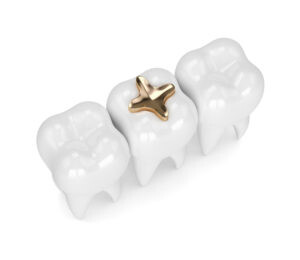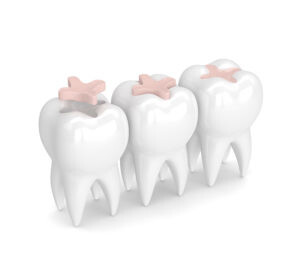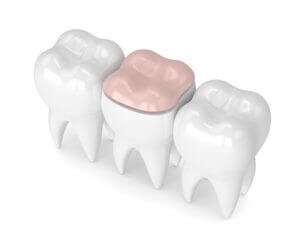Inlay & Onlay Restorations
Ready to Get Started?
What are Dental Inlays and Onlays?
Inlays and onlays are indirect dental restorations, which means they are made outside of your mouth in a laboratory. An inlay or onlay is typically used when a cavity is too large for a simple filling.
Inlays and onlays can increase a tooth’s strength by up to 75 percent.
There are many benefits of inlays and onlays, including:
- More resistant to fractures and damage than traditional cavity fillings
- Stain-resistant
- Improve the natural aesthetic and appearance of teeth
- Custom made to fit a patient’s tooth structure, color, and shape
- Depending on the patient’s cavity and fracture risk, they can last up to 30 years
Inlays
A dental inlay is made of a solid, custom-formed material. Depending on the cavity size and depth, inlays are either cast into shape with gold or milled into shape with porcelain.
An inlay is molded to fit into the grooves of your tooth. It does not extend over the cusps of the tooth.
Onlays
Inlay/Onlay Materials
Inlays and onlays can be made of gold, composite, or ceramic materials:Gold
In the past, gold was the material of choice for inlays and onlays because of its strength. Since gold is extremely durable, it protects weakened teeth cusps caused by cavities and trauma.
Today, with the introduction of tooth-colored restorations, gold dental restorations are less common.
Gold inlays are typically used if a cavity filling repeatedly fractures. Composite or ceramic (porcelain) inlays may be chosen for aesthetic reasons, but they are more prone to damage.
Some dentists recommend opting for gold inlays or onlays in areas of the mouth where appearance is not important, such as the back molars.

Advantages
- Very strong and malleable
- Extremely low chance of fracture
- Stain-resistant
Disadvantages
- Does not blend in with your natural tooth color
- More expensive than other restorations
Ceramic (Porcelain)
Ceramic inlays and onlays are made of porcelain. In dentistry, porcelain is used to create tooth-colored restorations that mimic the color, shape, and function of natural teeth.
Advantages
- Strong and durable material
- Less prone to fracture than traditional fillings
- Blends in with the color of your natural teeth
- Stain-resistant
Disadvantages
- More fragile than gold restorations
- Despite its strength, ceramic is a rigid material with an increased risk of fracture

Composite Resin
Composite inlays and onlays are used to fill cavities that are too large for traditional fillings. They are an alternative to gold or ceramic restorations and still perform the same functions.
Advantages
- Stronger and less prone to fracture than traditional dental fillings
- Tooth-colored, blends in with your natural teeth
Disadvantages
- Weaker than gold restorations
- Less malleable than gold or porcelain restorations
- Not stain-resistant

Inlay/Onlay Procedure: Step-By-Step
Step 1 - Cavity filling removal (if necessary)
Often times, inlays and onlays replace fractured or damaged cavity fillings.
If there is an existing filling in your tooth, your dentist will remove it prior to placement. Any cavitated tooth tissue is also removed, which leaves a "hollowed out" cavity.
Then, your dentist prepares and shapes your tooth, allowing for easier placement of the inlay or onlay.
Step 2 - Impression of the tooth (inlay/onlay mold)
During the first visit, a mold is taken of the cavitated or damaged tooth. This mold helps you and your dentist decide which material to use for the inlay or onlay (gold, ceramic, or composite). If ceramic is chosen, you will also pick the shade of the restoration during this visit.
Step 3 - Temporary filling placement
While the inlay or onlay is being prepared, a temporary filling is placed to seal the cavity. This helps prevent further decay and protects your tooth from thermal stimulation (sensitivity caused by cold or hot liquids).
Step 4 - Inlay/onlay placement
After the restoration is made, you will set up one more appointment with your dentist to have the inlay or onlay placed.
During this appointment, your dentist will administer a local anesthetic (only if requested) to reduce pain and increase comfort. Then, the temporary filling material is pulled off of the cavity and the inlay or onlay is cemented into your tooth.
Dentists can usually remove the temporary filling and place the inlay or onlay without causing significant discomfort.
Porcelain and composite inlays and onlays can now be made in-office with CAD/CAM technology and milling machines like CEREC. It's the same technology that dentists use to make "same-day" dental crowns. In these cases, you would undergo steps one and two, skip step three, and go straight to step four all within the same visit.
Aftercare Tips
The recovery time for inlays and onlays only takes a few days. However, your teeth are still susceptible to plaque and oral bacteria buildup over time. It is essential to practice good oral hygiene to keep the restorations clean and strong.
To reduce the chance of oral disease, dentists recommend the following tips:
Oral Hygiene
Inlays extend into the interdental areas of your mouth (between your teeth). These are difficult areas to clean and require regular interdental cleanings, such as flossing and using an interdental toothbrush. Basic oral care practices are also necessary, such as brushing twice a day and rinsing with mouthwash to kill bacteria.
Diet
Patients should reduce sugar intake after inlay or onlay placement. Dentists also recommend avoiding highly acidic foods and drinks. This includes candy, coffee, dairy, dark fruits, and processed food.
Check-Ups
Inlays and onlays should be routinely checked by your dentist every six months. During these appointments, your dentist will examine the restored tooth for signs of leakage, damage, and disease.
How Much Does an Inlay or Onlay Cost?
The cost of an inlay or onlay depends on the type of material used and where you live. Since inlays and onlays treat cavities and trauma-related dental conditions, insurance will cover part of the procedure.
Inlays and onlays are usually considered "major" dental procedures, which means insurance can cover up to 50 percent of the cost. In this case, you will only pay a couple of hundred dollars out-of-pocket.












